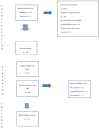Postcoital Vaginal Perforation and Evisceration in Women with No Prior Pelvic Surgery: Laparoscopic Management and Systematic Review of the Literature
- PMID: 34574671
- PMCID: PMC8464867
- DOI: 10.3390/ijerph18189746
Postcoital Vaginal Perforation and Evisceration in Women with No Prior Pelvic Surgery: Laparoscopic Management and Systematic Review of the Literature
Abstract
Objective: to evaluate risk factors, causes, management and surgical therapy of postcoital vaginal perforation and evisceration in women with no prior pelvic surgery.
Data sources: We used MEDLINE (PubMed), Scopus, Embase and Web of Science for our research. Our review includes all reports from 1980 to November 2020. The research strategy adopted included different combinations of the following terms: (intercourse) AND (coitus) AND (vaginal perforation).
Methods of study selection: we report a case of vaginal evisceration after consensual intercourse in a young and healthy woman. In addition, we performed a systematic review of vaginal perforations with or without evisceration in women without prior surgery or any other predisposing disease. All studies identified were listed by citation, title, authors and abstract. Duplicates were identified by an independent manual screening, performed by one researcher and then removed. For the eligibility process, two authors independently screened the title and abstracts of all non-duplicated papers and excluded those not pertinent to the topic.
Tabulation, integration and results: We have followed the PRISMA guidelines. Five manuscripts were detected through the references of the works that had been identified with the research on MEDLINE (PubMed), Scopus, Embase and Web of Science. We found 16 cases between 1980 and 2020. The young age and the virginal status represent the principal risk factors and all the lacerations occurred in the posterior vaginal fornix. The most common surgical technique was the laparotomic approach and, in the remaining cases, the laparoscopic and vaginal route was performed.
Conclusions: Post-coital vaginal perforation and evisceration in women with no prior pelvic surgery is a rare condition in the clinical practice and, when it is associated with evisceration it is a surgical emergency. Usually, these injuries are not life-threatening conditions but, a delay in diagnosis, can lead to severe complications. In consideration of the high heterogeneity of the data in the literature, it is essential to define a diagnostic-therapeutic management for the patients with vaginal perforation. With our review, we try to identify the associated risk factors, the best and fastest diagnosis, and the best surgical approach. We believe that a combined vaginal and laparoscopic approach can be the best surgical treatment, useful to diagnose injuries of the abdominal organs and to improve postoperative outcome.
Keywords: evisceration; laparoscopy; postcoital; sexual intercourse; vaginal perforation; vaginal rupture.
Conflict of interest statement
The authors declare no conflict of interest.
Figures
Similar articles
-
Surgical interventions for the management of chronic pelvic pain in women.Cochrane Database Syst Rev. 2021 Dec 20;12(12):CD008212. doi: 10.1002/14651858.CD008212.pub2. Cochrane Database Syst Rev. 2021. PMID: 34923620 Free PMC article.
-
Sertindole for schizophrenia.Cochrane Database Syst Rev. 2005 Jul 20;2005(3):CD001715. doi: 10.1002/14651858.CD001715.pub2. Cochrane Database Syst Rev. 2005. PMID: 16034864 Free PMC article.
-
Signs and symptoms to determine if a patient presenting in primary care or hospital outpatient settings has COVID-19.Cochrane Database Syst Rev. 2022 May 20;5(5):CD013665. doi: 10.1002/14651858.CD013665.pub3. Cochrane Database Syst Rev. 2022. PMID: 35593186 Free PMC article.
-
Taxane monotherapy regimens for the treatment of recurrent epithelial ovarian cancer.Cochrane Database Syst Rev. 2022 Jul 12;7(7):CD008766. doi: 10.1002/14651858.CD008766.pub3. Cochrane Database Syst Rev. 2022. PMID: 35866378 Free PMC article.
-
Endometrial injury for pregnancy following sexual intercourse or intrauterine insemination.Cochrane Database Syst Rev. 2022 Oct 24;10(10):CD011424. doi: 10.1002/14651858.CD011424.pub4. Cochrane Database Syst Rev. 2022. PMID: 36278845 Free PMC article.
Cited by
-
Provoked Vestibulodynia and Topical Treatment: A New Option.Healthcare (Basel). 2022 Apr 30;10(5):830. doi: 10.3390/healthcare10050830. Healthcare (Basel). 2022. PMID: 35627968 Free PMC article.
-
Ladylift® non-ablative laser technology for the treatment of menopausal vestibulodynia and genitourinary syndrome.Prz Menopauzalny. 2022 Dec;21(4):253-258. doi: 10.5114/pm.2022.124015. Epub 2022 Dec 30. Prz Menopauzalny. 2022. PMID: 36704770 Free PMC article.
-
Vaginal injuries after consensual sexual intercourse - a survey among office-based gynecologists in Hamburg, Germany.Forensic Sci Med Pathol. 2022 Sep;18(3):352-358. doi: 10.1007/s12024-022-00488-z. Epub 2022 Jun 18. Forensic Sci Med Pathol. 2022. PMID: 35716294 Free PMC article.
-
Strangulated bowel obstruction caused by vaginal perforation due to vaginal cancer in a patient with chronic uterine prolapse.BMJ Case Rep. 2023 Dec 12;16(12):e255815. doi: 10.1136/bcr-2023-255815. BMJ Case Rep. 2023. PMID: 38086574 Free PMC article.
-
Lived experiences of refugee women with vaginal fistula in Nakivale and Oruchinga refugee settlements, Isingiro District, Uganda.BMC Womens Health. 2024 Feb 2;24(1):85. doi: 10.1186/s12905-024-02926-2. BMC Womens Health. 2024. PMID: 38302939 Free PMC article.
References
Publication types
MeSH terms
LinkOut - more resources
Full Text Sources
Medical
Research Materials






